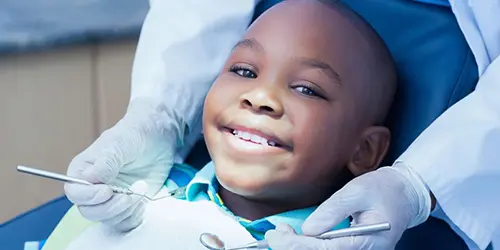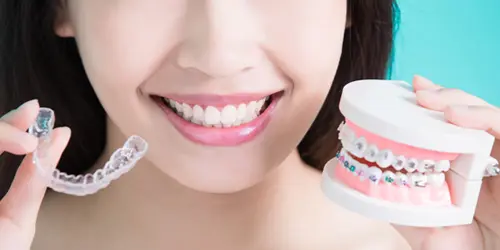Our children are our lives. They represent everything that is great about life, and we would do absolutely anything for them to be happy and healthy. Children’s health starts with their teeth and mouths. Unfortunately, some people believe that since children’s teeth will eventually fall out and be replaced by adult teeth, that dental care for children is not that big of a deal. But they cannot be more wrong. The health of children’s teeth has everything to do with the health of adult teeth. What happens to baby teeth is also bound to happen to adult teeth. For that reason, bringing your toddler to the dentist should be right up there on your priority list. So keep an eye out for the signs to bring your toddler to the dentist\orthodontist as we’ll explain them in a little bit.
Why Are Children’s Teeth So Important?
Normally, your toddler should start the teething process around 6 to 7 months of age. This process continues until he\she is about 2 years old. The baby teeth will remain with your child until he reaches about 6 or 7 years of age, and they start falling out sequentially and are replaced by adult teeth all the way up to the age of 14 years.
This means that baby teeth are much more important than most people think for many reasons:
- They remain with the child for over 4 years. Not taking care of them and not watching out for the signs to bring your toddler to the dentist\orthodontist when there is trouble means your child could be in pain for a long period of time.
- Most problems of baby teeth can be easily communicated to adult teeth. They grow in crypts in the bone just beneath the roots of baby teeth, so any infection can find its way to the growing adult teeth, causing a multitude of problems.
- Early loss of baby teeth can have a detrimental effect on his\her jaw’s growth. The remaining teeth start to creep into the empty space, so much so that the adult teeth may have nowhere to properly erupt. In these cases, your child will probably need braces in the future.
When Should A Toddler Start Going To The Dentist?
As we stated before, the first tooth appears at about 6 months of age. Most dental books – as well as parenting books – state that the first dental visit should be around that time. We understand that your toddler may still be too young to understand what is going on, but studies show that such an early visit can have a great role in shaping the child’s future experiences. No treatment is carried out then, just acquainting the toddler to the surroundings, and having him\her build a positive, fun experience with the dentist.
The first actual dental visit should be around 2 to 3 years of age. By that time, most children are very aware of their surroundings. They would know that they are in the dentist’s office and that the dentist will be a big part of their lives going forward. Those 2 visits are key to a healthy relationship with the dentist, which could be the defining line between great and poor dental health.
Signs To Bring Your Toddler To The Dentist or Orthodontist
The previous 2 visits shouldn’t be related to any problems. They should happen regardless of whether there were any complaints or pain with your child’s teeth. However, there are some signs to bring your toddler to the dentist\orthodontist, signs that just signal trouble. So be on the lookout for any of the following:
-
Constant crying with an indication of pain in the mouth:
While most toddlers can’t speak to interpret where their pain is coming from, they can certainly point – even subconsciously – to their source of pain. You’ll find your child always putting their hands and fingers in their mouths. They’ll be constantly drooling. They start biting into anything they get their hands on. All these signs point to a problem inside the mouth.
-
White spots on the surface of the teeth:
You have to watch your child’s teeth with your eyes. Take a quick look when they open their mouths for eating or when you brush their teeth. White spots can indicate 3 things:
- They could be an early sign of decay.
- They could indicate that your child consumes a large amount of their toothpaste, causing what is known as Fluorosis.
- They could indicate an illness somewhere else in the body.
All these signal that a dental visit is due.
-
Brown spots on the teeth:
This is where it gets serious. Brown spots on baby teeth definitely mean decay. They can be noticeable on the front teeth, or – more commonly – on the back teeth. At the first hint of a brown color, schedule an appointment with the pediatric dentist immediately.
-
Missing teeth beyond the age of 2 years:
All baby teeth should have come out by 2 years of age. If you notice any missing teeth beyond that age, then your dentist\orthodontist should take a look. Missing teeth could have no consequences if the adult teeth are all present, but if any of the adult teeth are also missing, continuous monitoring is essential to ensure that they won’t need braces.
How Can I Avoid All This Trouble?
Avoiding children’s tooth decay and other problems may be challenging. Unlike taking care of yourself, your toddler is exploring the world, and he\she is bound to do some things beyond your control. However, follow these guidelines to avoid – or at least control – child tooth decay:
- Limit their sweets consumption. If you can’t control the amount, at least control the frequency. Make them eat all the sweets at once, preferably in the morning.
- Avoid sweetened cough syrups and medications. They contain an unusually high amount of sugars and can rot the teeth faster than you think.
- Breastfeeding is always better than bottle feeding. But if you use bottle feeding, make sure you don’t add sweeteners to the formula, and that your child doesn’t sleep with the bottle in his\her mouth.
- Don’t coat pacifiers with honey. Sticky foods have a doubly dangerous effect on teeth.
So as you can see, it is not just about watching out for signs to bring your toddler to the dentist\orthodontist, it is also about making sure they don’t need that visit at all. Prevention is better than cure, but if you do need a cure, it is better to see the signs early and treat the problem head-on.
Tags: Child dentist NY, Pediatric dentist, teething, Toddler Teeth

